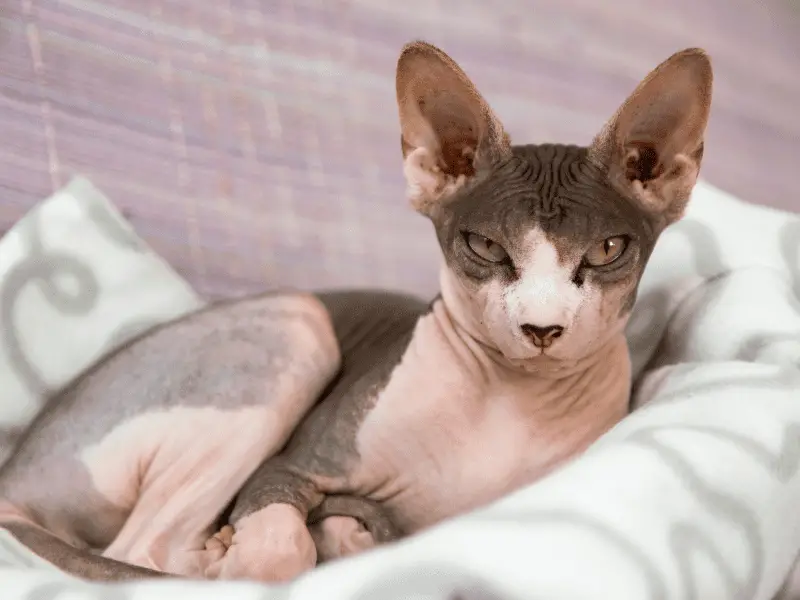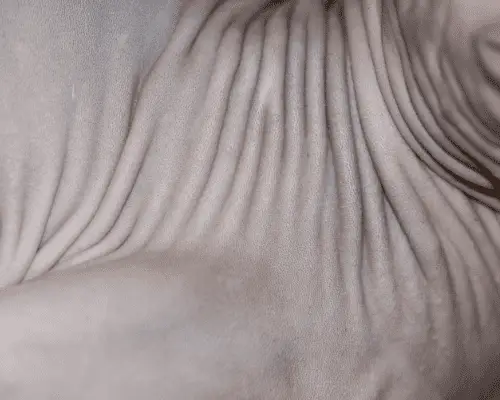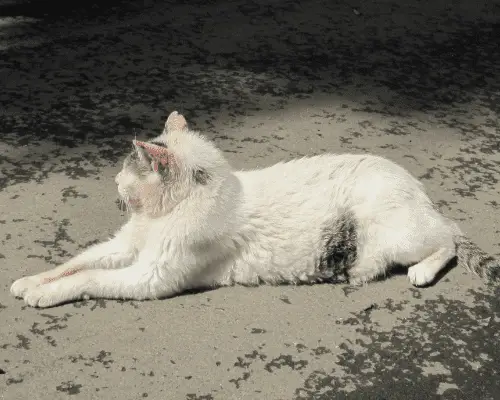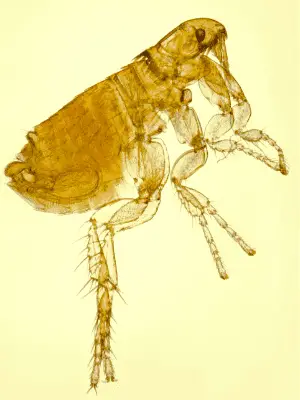This article contains affiliate links, and we may earn a commission at no cost to you if you choose to purchase through these links. I never recommend products that I do not trust or will not advise my veterinary clients and patients to use.

Sphynx cats have unique skin considerations. Due to their special genetics owning them, their striking looks, they are not only prone to getting cold quickly, but they are also prone to certain skin conditions.
Sphynx cats are not entirely hairless. Most sphynx cats have a soft down or peach fuzz-like fur over their entire bodies. They commonly also have short hairs on their face, ears, and feet that have a velvet or suede-like feel.
Sphynx cats are prone to skin conditions such as sunburn, urticaria pigementosa, and certain skin infections. Therefore, sphynx cats need regular bathing and a good quality, species-appropriate diet to minimize their risk of developing certain skin conditions.
What Makes A Sphynx’s Skin So Different?
Did you know that the number of hair follicles in an area of sphynx skin is similar to the number of hair follicles in cats with furry coats?
The difference is that while the sphynx cats’ hair follicles still grow hairs, the hairs are abnormally keratinized, meaning they do not have the integrity and structure of a regular strand of hair. In addition, the bulbs of the hairs (where the hair attaches to the follicle and grows from) are often abnormally shaped, and hairs can, therefore, easily be pulled from the follicles.
Some sphynx follicles only produce fine peach fuzz-like hairs, and other follicles produce abnormal hair shafts that are so fine and small that they can only be viewed under a microscope.

Because of their hairless state, sphynx cats need to be bathed every so often. The skin continually produces oils called sebum. The sebaceous glands usually sit next to the hair follicles in the dermis (the deeper layer of the skin).
In furry animals, the hair wicks the oils away from the skin, preventing a build-up of oily secretion, but in the sphynx, the oil has nowhere to go and accumulates on the surface of the skin and between skin folds, making your sphynx feel greasy and creating an ideal environment for bacteria and yeast to grow.
The frequency of bathing needed can differ from one sphynx to the next. A good general rule is that a sphynx with healthy skin must be bathed using a fragrance-free, mild veterinary or baby shampoo every 7-10 days.
Skin Conditions Sphynx Cats Are Prone To
Sunburn
Due to their lack of fur and, in some cases, lack of pigmentation, Sphynx cats are prone to sunburn. This is one of the many reasons why Sphynx cats should be kept as indoor-only cats.
Sphynx cats with unpigmented skin patches (often seen as pink patches) are especially prone to sunburn due to the lack of melanin pigment in the skin in these areas. Melanin helps protect the skin against sun damage but does not prevent sunburn and the other side effects of long-term sun exposure. Just think of how someone with darker skin can spend much longer in direct sun before getting sunburnt than someone with very fair skin.
To read all about the dangers of sun exposure in sphynx cats and UV protection tips, have a look at this article.
Pet Vet Tip: Is your sphynx cat pink or albino? Read this article to learn about albinism in sphynx cats and how it relates to common color variations of sphynx cats like thermals or color point sphynxes.
How To Prevent Your Sphynx From Getting Sunburn
Do not apply human sunblock to your sphynx, as some ingredients in the sunblock may be toxic. There is animal-safe sunblock available such as this non-toxic pet sun skin protector. Since cats are meticulous groomers, you must ensure that you never apply anything to their skin that will be unsafe for them to ingest.
Alternatively, cover unpigmented skin with a cat shirt or a toddler shirt to protect your sphynx’s skin from the sun if they enjoy lounging in sunny spots.
Windows help prevent sunburn by blocking most of the shorter wavelength sunlight (UVB-rays) that cause sunburn, but most windows are ineffective in blocking the more harmful UVA rays that cause the type of skin damage that predisposes to skin cancer.
Skin Cancer
The most common type of skin cancer in hairless and white cats is squamous cell carcinoma, often secondary to chronic solar keratosis (chronic sunburn causing thickening of the skin).
Squamous cell carcinoma, or SCC, is commonly found on unpigmented areas on the face and ears of a cat and often first appears as sores that do not heal. With time these lesions may become raised or increase in size with larger, open, non-healing sores.
Your vet will have to take a skin biopsy or do a fine needle aspirate to look at the skin cells under the microscope to diagnose skin cancer.
Depending on the location and size of the lesion, surgical removal of the affected skin may be considered. This may then be followed up by topical chemotherapy drugs or local radiation therapy.
In some cases where surgery is not indicated, topical chemotherapy drugs, cryotherapy, and local radiation therapy may be used.

Urticaria Pigmentosa
Although this condition is very rare, sphynx cats are overrepresented in the cat population affected by this severely itchy skin condition that causes raised, red bumps on the skin.
It is important to note that there are many causes of red itchy bumps on your cat’s skin, and if you notice these symptoms, it is best to get your kitty to a vet for a proper diagnosis and appropriate treatment.
Urticaria pigmentosa is caused by a build-up of defective mast cells in the skin, causing itchy red bumps (raised rash with a distinct border) on the skin. Mast cells are part of the immune system and play an essential role in allergic skin reactions by releasing specific proteins that alert the immune system to a possible allergen and cause itchiness.
Think of how a mosquito bite or bee sting can be itchy. Mast cells play an essential part (among other immune system mechanisms) in the red, itchy skin reaction we see in, for example, insect bites.
In urticaria pigmentosa, the mast cells mainly build up in the skin, but in some cases, the mast cells can accumulate in other organs such as the lymph nodes, spleen, liver, and bone marrow.
In most cases of urticaria pigmentosa, the itchy skin lesions are the only symptom; however, diarrhea and lethargy may also be seen in some cases. The condition may be diagnosed using blood tests or skin biopsies.
The condition is commonly treated with glucocorticoids, antihistamines, and Omega 3 fatty acids. Even though the lesions may take many months to disappear completely, most cats eventually recover from urticaria pigmentosa. However, owners of cats suffering from this condition must be aware that it may recur at a later stage in life, so they may need repeat treatment.
Dermatitis
Dermatitis is a blanket term used to describe skin inflammation and infection. There are hundreds of different causes of dermatitis, but in this section, we will focus on bacterial and yeast infections secondary to a compromised skin barrier, the type of infections that Sphynx cats are predisposed to.
To understand why these types of infections occur, we need to know how healthy skin resists infection.
Healthy skin has several bacteria, yeasts, and fungi living on it without causing any problems. This is due to healthy skin naturally resisting overgrowth and infection by these microbes (also called commensal microbes) through mechanisms such as pH, sebum production, and the cells from the immune system that reside within the skin.
These microbes will only cause infection if the skin barrier is compromised, for example, if the immune system is suppressed or underdeveloped (as in very young kittens) or if there is another cause for skin inflammation, such as an allergic reaction. An overgrowth of bacteria or yeast due to an accumulation of sebum on the skin can also lead to skin infections.
Many skin infections in Sphynx cats are secondary to an underlying food allergy. Unfortunately, it is complicated to pinpoint precisely what your sphynx may be allergic to with decent accuracy, even with the most comprehensive allergy testing panel, as the results are often ambiguous at best.
I advise trying out a different type of food and seeing how your cat responds to it. An excellent general rule is to find cat food that is as high quality and minimally processed as your budget allows. You can speak to your vet about the options for your Sphynx.
Remember that you will have to gradually transition onto a new diet over several days to prevent digestive upset due to a sudden dietary change. In addition, you will need to feed the new diet exclusively (as in no treats or snacks) for at least four weeks to give your Sphynx time to respond to the adjustments to see whether the new diet improves their skin condition.
Pet Vet Tip: To read more about how food sensitivities can aggravate skin conditions, have a look at this article on chicken and other food allergies in sphynx cats. And for a guide on what food is best for sphynx cats, check out this article.
Malassezia or Yeast Infection
This is probably the most common type of skin infection in Sphynx cats because they have a much larger population of normal or commensal Malassezia living on the skin than longer-haired cats. It only takes a slightly compromised skin barrier to cause a Malassezia overgrowth and subsequent infection to set in.

Unfortunately, fungi and yeast can be stubborn and often only clear up after months of treatment rather than weeks. Therefore, vets commonly use medicated shampoo containing an antifungal and antiseptic to treat these infections.
As a general rule, medicated shampoos must be worked into the skin and left on the skin for 10 minutes at a time to be effective. I know cats hate being covered in sticky shampoo, but this is, unfortunately, the most effective way of treating these infections and has the least side effects. You can try playing with your cat to distract them or feed them while waiting for the 10 minutes to pass.
Oral medication may sometimes also be used, but this is usually reserved for deep or widespread skin infections.
Pet Vet Tip: If you would like to learn more about the causes, treatment, and prevention strategies of Malassezia dermatitis in Sphynx cats, please have a look at this article.
Bacterial Skin Infection
Along with Malassezia, some of the normal bacteria living on the skin, such as staphylococcus species, may also take advantage of the compromised skin barrier and cause a secondary bacterial infection.
This can be treated using oral antibiotics, but medicated shampoos are equally effective at treating superficial bacterial infections. It is often only when deeper layers of the skin are involved that oral antibiotics may become necessary. Your vet will prescribe the appropriate antibiotic or topical treatment depending on your Sphynx’s specific presentation and needs.
Ring Worm
Like most other animals and humans, Sphynx cats can get ringworm; however, sphynx cats are not more susceptible to getting ringworm than other cat breeds.
Ringworm (feline dermatophytosis) is a superficial, contagious fungal infection of the skin, hair, and nails. Despite the name, ringworm has nothing to do with worms but rather with many different types of fungi that cause similar lesions. In cats, the most common culprit is the fungus Microsporum canis.
To see what ringworm looks like on sphynx skin and how it is treated, look at this article.
Dirty Ears
The ears are an extension of the skin, and the same microorganisms that live on the skin live in the ears.
Sphynx cats need their ears cleaned at least once weekly using a damp (not wet) wipe. These anti-microbial ear wipes are an excellent example of a safe product to wipe your cat’s ears.
Not cleaning your sphynx’s ears regularly will lead to a build-up of wax, sebum, and dead skin cells that will cause skin irritation and eventually lead to compromise of the skin barrier, as mentioned in the discussion of dermatitis.
Ear infections can be excruciating, so it is best to try to prevent this by keeping the ears clean.
Pet Vet Tips: For more tips and tricks on how to keep your sphynx’s ears clean, have a look at this helpful article.
Fleas and Mites
Yes, Sphynx cats can still get fleas despite their lack of fur! Luckily it is easy to spot fleas on your sphynx as there is no hair for them to hide in, and sphynx owners often pick this up quickly.
However, ear mites are rarely seen and may appear similar to an ear infection with severely itchy and painful ears with a possible dark discharge. Make sure to get your sphynx checked out by a vet to see whether they need a tick and flea treatment.
In the meantime, you can have a look at this article for more information on how and when fleas may infect sphynx cats.

Hyperpigmentation
Sphynx cats may develop benign dark spots on their skin as they age or spend more time sunbathing. These spots may sometimes fade with time if skin exposure is limited, but more often, these spots are permanent.
Avoiding possible skin irritants, including shampoo with potential skin-irritating ingredients such as fragrance and excessive sun exposure, is best to prevent pigmentation.

Skin Scrapes And Superficial Abrasions
Fur does much more than keep a cat warm – it also protects against physical damage. Thus, a sphynx is prone to superficial scratches and abrasions, especially if she enjoys playing rough!
Often these superficial scrapes heal just fine on their own; however, they may cause depigmentation in some sphynxes after healing.
Provided that the scratch is not total skin thickness, your cat should be fine with daily wound cleaning with saline or an antiseptic and perhaps a wound ointment such as Silver Honey. But, if in doubt, rather be safe and have it checked out by your vet.
Other Frequently Asked Questions
Are Sphynx Cats Hypoallergenic?
Sphynxes are not hypoallergenic cats. They still produce the protein in their saliva that most people with cat allergies are allergic to; however, some people with cat allergies report being more tolerant of the sphynx.
What is Alopecia?
Alopecia means loss of hair. We know that the sphynx is not completely hairless and that most sphynxes have a layer of peach fuzz over most parts of their body. This is due to the abnormal development of air (genetically ‘abnormal’ hair follicles). Unfortunately, the abnormal hair follicles are also what places the sphynx at risk for developing hair follicle disorders that could result in alopecia.
Pet Vet Tip: In some cases, sphynx cats may start to grow hair! Have a look at this article to find out when and why this happens.
Do Sphynx Cats Get Pimples And Blackheads?
Sphynx cats can get pimples and blackheads similar to what humans may get. These are called comedones are usually appear on the chin and belly. A substantial amount of comedones is typically a symptom of an endocrine or skin barrier disorder, and vet advice should be sought.
Is It Normal For Sphynx Cats To Not Have Whiskers?
It is normal for most sphynx cats to have no whiskers or eyelashes. However, some sphynxes have a few thin whiskers. This is because sphynx cats’ hair follicles do not produce normal keratin (the protein that hair consists of), and they, therefore, have very fine or rudimentary hairs.
Can Sphynx Cats Get Fleas And Mites?
Despite their lack of fur, mites and fleas can still infect sphynx cats. Luckily, ectoparasite infections are easily noticeable on the skin of a sphynx and can easily be treated using a cat-safe topical ectoparasiticide. This article explains how to best treat and prevent fleas and mites in sphynx cats.
You may also find the following articles helpful:
- Can a Sphynx Cat Give Birth to Kittens with Fur?
- Why Is My Sphynx Cat Always Hungry? The Sphynx’s High Metabolism Explained
- Dirty Ears In Sphynx Cats: Tips And Care Guide By A Vet
Resources
- Gandolfi, B., Outerbridge, C., Beresford, L., Myers, J., Pimentel, M., Alhaddad, H., Grahn, J., Grahn, R. and Lyons, L., 2010. The naked truth: Sphynx and Devon Rex cat breed mutations in KRT71. Mammalian Genome, [online] 21(9-10), pp.509-515. Available at: <https://link.springer.com/article/10.1007/s00335-010-9290-6?page=4&page=5>.
- Genovese, D., Johnson, T., Lamb, K. and Gram, W., 2014. Histological and dermatoscopic description of sphynx cat skin. Veterinary Dermatology, [online] 25(6), pp.523-e90. Available at: <https://onlinelibrary.wiley.com/doi/abs/10.1111/vde.12162>.
- Sharkey, L., Radin, M., and Seelig, D., 2020. Veterinary cytology. 1st ed.
- Volk, A., Belyavin, C., Varjonen, K., Cadiergues, M., Stevens, K. and Bond, R., 2010. Malassezia pachydermatis and M nana predominate amongst the cutaneous mycobiota of Sphynx cats. Journal of Feline Medicine and Surgery, [online] 12(12), pp.917-922. Available at: <https://www.sciencedirect.com/science/article/abs/pii/S1098612X10002214>.

